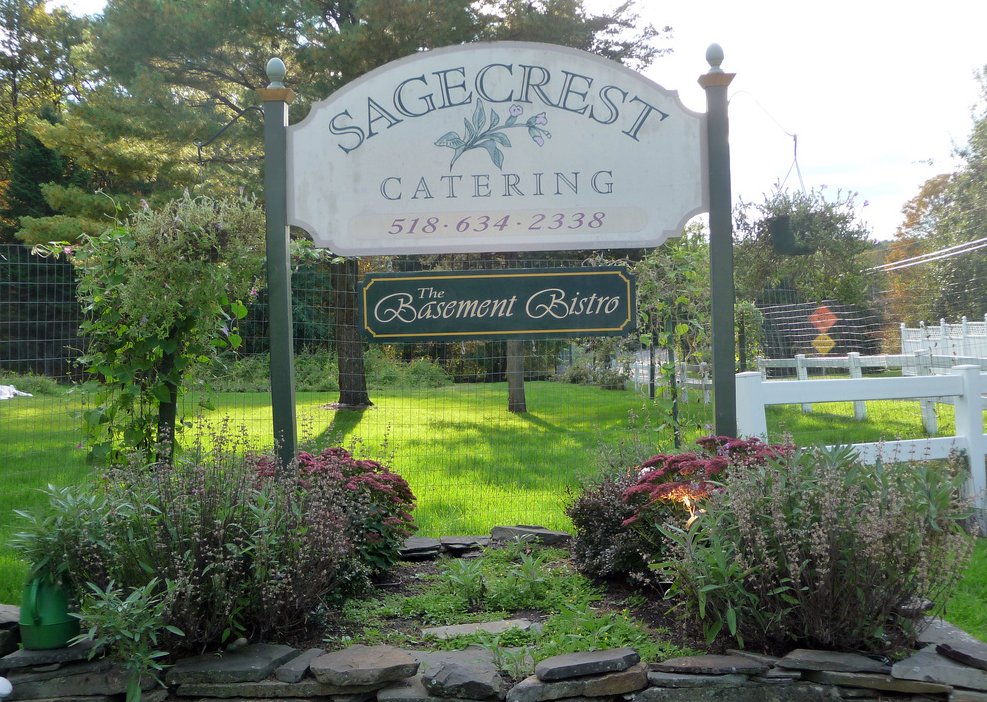NYC-area food blog Eater.com has a great map of current restaurant deals in New York City. (Currently all of them are in Manhattan.) While it's hardly all-encompassing, it's a good start. Most of the deals are Sunday/Monday night specials (burgers and a beer for $15 is common) or extensions of the Winter Restaurant Week menus.
Introducing the Eater DEALFEED Map
Monday, February 2, 2009
Monday, October 27, 2008
Hands on with Rosetta Stone

For the past month, a few other dealnews staffers and I decided to learn Italian using different methods for a feature. Louis Ramirez got Pimsleur, I got Rosetta Stone online, and Jeff Somogyi used whatever free stuff he could find online, which I imagine was mostly podcasts.
Anyways, we were to use the systems as recommended for 30 days, after which we would take a test to determine which method worked the best.
You can find the results posted over on dealnews, but I thought I'd take a moment to expand on my experience with Rosetta Stone.
1. Rosetta Stone is brilliant!
Seriously. It's probably the best language learning software out there. It was a simple as logging into the Rosetta Stone website, testing the mic, and plugging away. The image-based instruction, matched with the complete immersion in Italian, proved to be the most effective method of learning a language I've encountered to date. (In the past, I've attempted - at varying degrees of fail - to learn French, Korean, Japanese, Portuguese, and Danish.) Despite my slow progress through my Rosetta Stone courses - due to an unusually hectic month, not to any troubles with the coursework - I feel like I made decent strides into learning the language. And sure, "Le donne nuotano" and "la bicicletta e verde" may not come up in my life any time soon, but these phrases stuck in my head, along with dozens more. In fact, I can even understand them. And pronounce them with what I surmount to be a generic Italian accent. Result!
2. Rosetta Stone is friggin expensive!
Sure, I probably should have looked at the sticker at sometime during the learning experience, but it completely slipped my mind. I didn't learn about Rosetta Stone's exorbitant fees until after the test was all said and done. After my experience with the Italian program, I had the inkling to sign up for the French version so I could brush up on a language I knew somewhat conversationally back in the day. But at $199 for a six-month subscription, I quickly gave up on that idea. I really like the software and the method of instruction, but the price is a bit prohibitive. That said, if you've got the time on your hands, you could probably fly through the three lessons of a language in that time period; for comparison, to buy the retail-boxed version of all three lessons would cost $549 directly from Rosetta Stone. But it's frankly just a bit too dear for me.
Anyways, what I came out of this experience with was an appreciation for the methodology of Rosetta Stone's instruction. For those looking to seriously learn a language, I can see Rosetta Stone as being a wonderful tool in preparation for serious coursework in the pursuit of said language. It doesn't prepare you for a long weekend in a foreign land - I didn't learn what "bathroom" or "hotel room with two beds" are in Italian. What it does give you is a solid foundation for learning a language of your choice, and they currently offer 31 languages to choose from. So, while your $199 might not allow you to, say, order another beer in Farsi*, it will set you up with a solid understanding of the basics of that language.
* I don't know how to write it in arabic script, but it's something like "Mon bishtar ahjool mee-choum". Don't ask me why I know that.
Monday, October 6, 2008
The best $75 meal in the country
I'm sure you're asking yourself, "how can a $75 meal be considered a bargain?" I would've asked the same question myself before this past Saturday night at 10:10 pm. It was at that precise time, after which having just enjoyed a five hour and 20 minute meal at the Basement Bistro in Earlton, NY, that I realized that I had just enjoyed the best meal of my life.
Suddenly, $75 didn't seem like an expensive meal. After a five hour meal with Chef Damon Baehrel - owner, host, chef, waiter, sommelier, farmer, cheesemaker, butcher, dishwasher, carpenter, etc. - at the helm, I found myself wondering how he could possibly serve so much for such little money.
How does he do it? Chef Baehrel debunks the old adage by being not only a Jack of All Trades, but also a master of all of them. It's not just that he grows his own produce on the grounds surrounding his restaurant, and organically at that, but he also makes his own cheeses (from locally-sourced organic milk), bakes his own breads (with wheat from a local grain mill), cures his own charcuterie (from meat raised specifically for him in an organic, sustainable fashion), churns his own butter, and so on. Besides mastering traditional methods, his techniques - all self-taught - would be right at home on the menus of cutting-edge restaurants like wd~50 in NYC and Alinea in Chicago. That spinach powder adorning the stuffed heirloom tomato? Chef Baehrel dried the spinach and pulverized it into a fine dust himself. He's currently curing tomato "bacon" that he'll be serving beginning in January. Wylie Dufresne and Grant Achatz could learn a thing or two from this guy.
Another aspect of the Basement Bistro that helps keeps the cost down is its location. Although it's not an actual "bistro", it is located in a basement. A basement in a run-of-the-mill suburban-style house. (Which, by the way, was also built by Chef Baehrel.) The dining room was remodeled a half-dozen years ago, but it's still pretty basic by most standards. But its stripped-down atmosphere only goes to further the allure of this place - not only are you eating an incredible meal, you're eating that meal in some guy's basement.
The final measure in place to keep the price down is the payroll. Or lack thereof, I should say. One of the most impressive features of the Basement Bistro is that it's pretty much a solitary undertaking. Besides some help from his wife on the business side of things, and a former culinary intern who has transitioned to a part-time reservationist, Chef Baehrel is doing it all by himself. And he has been, while also running a catering company, cooking classes, and restaurant consulting outfit, for the past 18 years. The man must never sleep. (And on certain nights, he doesn't. When we walked out at 10:10 pm this past Saturday night, he began preparing for a party of 20 that would be joining him at 11 pm. He suspected that he'd maybe get an hour nap in before he had to start making the bread the next morning at 6 am.)
I could go on and on about what makes this place so special. And perhaps I will upon subsequent vists. (The menu changes daily, but I'm shooting for quarterly pilgrimages.) But at this time I'm just going to let the food speak for itself. I won't critique each course - there were far too many highs and nothing, and I mean nothing, that wasn't at least very good. Most dishes, in fact, leaned towards magnificent, or revelatory, or just simply jaw-dropping. (My dining companions, which consisted of my wife and my two amazing friends Mark and Cris who introduced me to this place, didn't quite get it when I said that a dish was "slap yo' mama" good, but I can surmount that a few of you out there will understand what I'm talking about.) I apologize if I didn't catch everything perfectly - it's incredibly hard to write when you're trying to take in all of what Chef Baehrel is saying, and even harder when a plate of his food is staring up at you.
So, without further ado, here's a pictorial journey through a meal at the Basement Bistro.
Entrance from the road:
Entrance to the restaurant:

Bread:
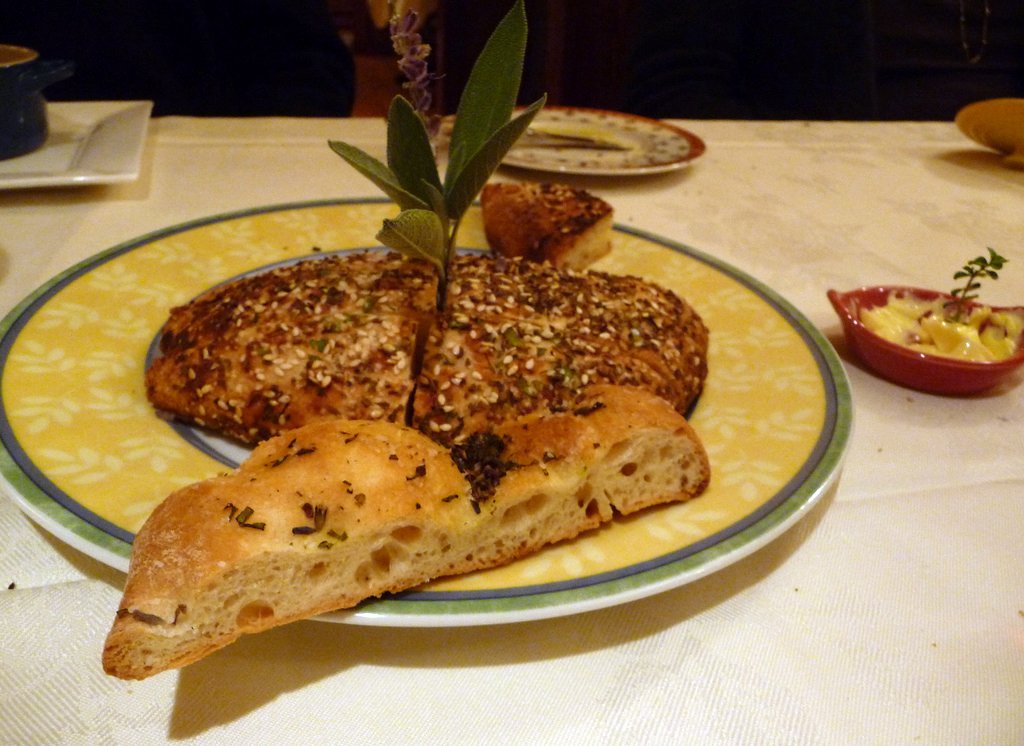 Housemade bread: A focaccia-style bread made with basil flowers, and a sort of "everything bread" made with homemade onion powder, among other things. Served with freshly-churned butter and olive oil imported from a customer's olive farm in Greece.
Housemade bread: A focaccia-style bread made with basil flowers, and a sort of "everything bread" made with homemade onion powder, among other things. Served with freshly-churned butter and olive oil imported from a customer's olive farm in Greece.
First Course:
 Charcuterie (all cured in-house, clockwise from top):
Charcuterie (all cured in-house, clockwise from top):
Goose "salami" Icelandic lamb cured with coriander
Grass-fed beef brasaola
Kurobuta (Berkshire) pork "speck"
Small bites (from top):
Nasturtium flower, coated in rice flour and baked, served on a sunchoke puree*
Baby green beans wrapped in lamb prosciutto with heirloom carrot puree
Heirloom tomato with swiss chard and spinach powder
Cheeses (all made in-house, clockwise from top):
Blue cheese with sage
Camembert-style cheese
(unknown variety with fried parsley)
Earlton cheese (chef's own recipe)
Goat chevre with apple and nectarine confit
* It should be noted that most of his purees and sauces use a rutabaga stock at various reductions instead of cream or butter. It's amazing how much of a creamy texture this method gives a sauce without adding extra fat
Second Course:
 Savory Cones: Parsley-oil "cones" with pureed purple bush beans, green eggplant, and green sunflower seeds
Savory Cones: Parsley-oil "cones" with pureed purple bush beans, green eggplant, and green sunflower seeds
Third Course:
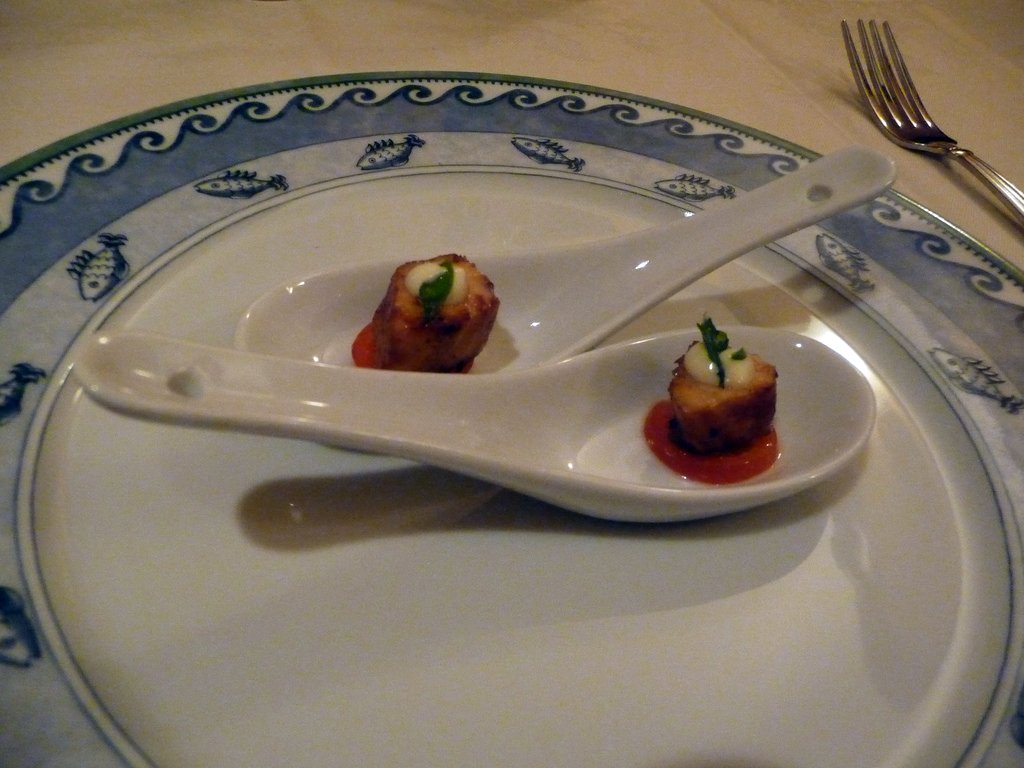 Salmon "BLT": Peachwood-smoked salmon, basil, heirloom tomato, lavender and marjoram aioli
Salmon "BLT": Peachwood-smoked salmon, basil, heirloom tomato, lavender and marjoram aioli
Fourth Course:
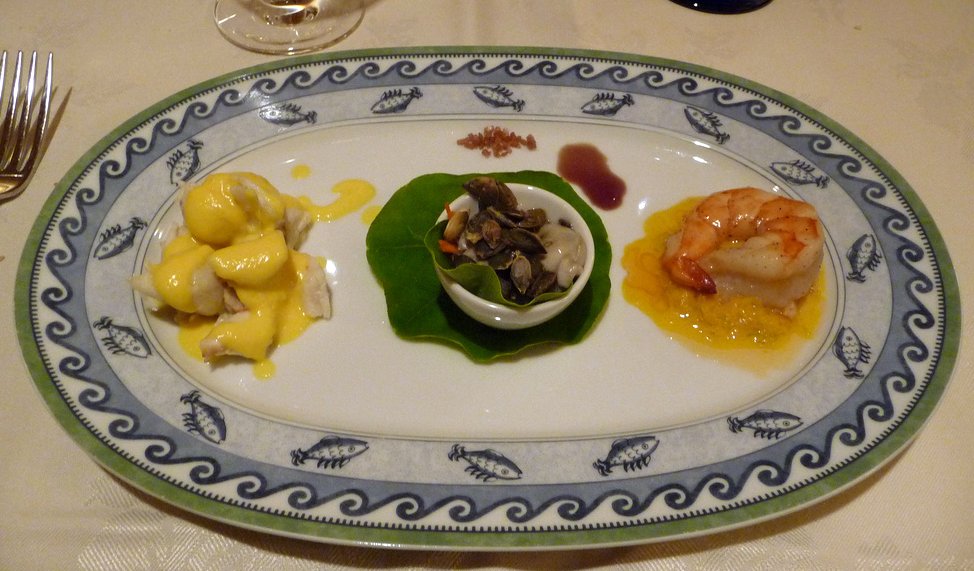 Seafood course* (from left to right):
Seafood course* (from left to right):
Peekytoe crab with squash blossom puree and cauliflower powder
Oyster poached in tomato water with heirloom carrot salad and squash seeds
Salt and pepper prawn with saffron cabbage "slaw"
* All seafood is provided by a vendor from Maine, who makes the Basement Bistro the first stop on the way to New York City
Fifth Course:
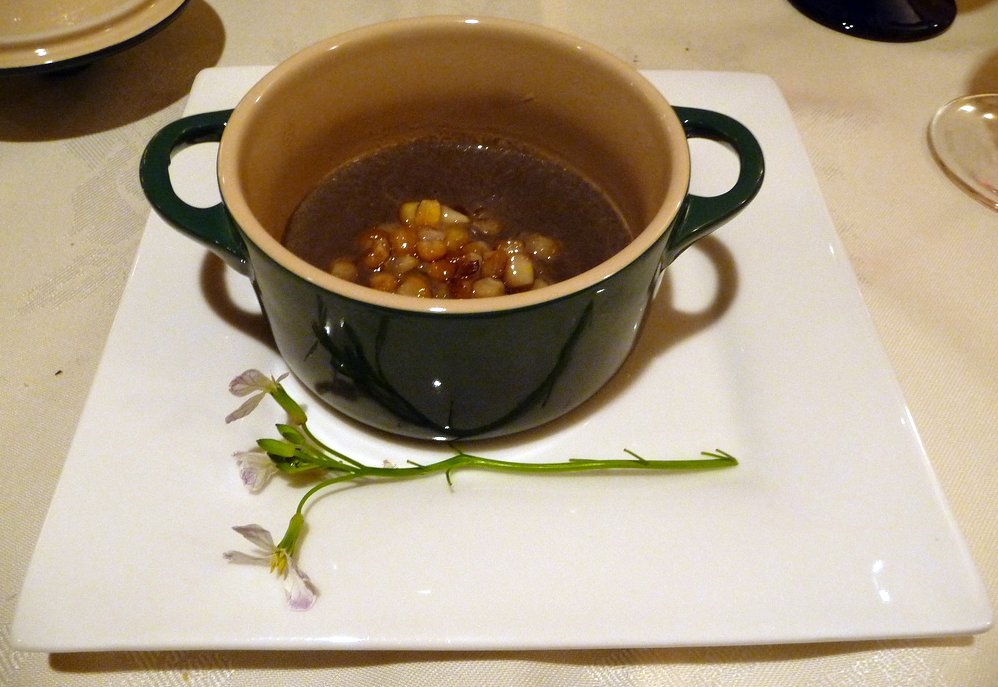 Puffball "Soup": Puffball mushroom puree with applewood smoked corn, watermelon radish flower
Puffball "Soup": Puffball mushroom puree with applewood smoked corn, watermelon radish flower
Sixth Course:
 Frozen duo*:
Frozen duo*:
Wild pink current sorbet
Oven-roasted peach gelato
* Instead of using sugar or another sweetener, he uses unripened grape juice to sweeten his frozen confections
Seventh Course:
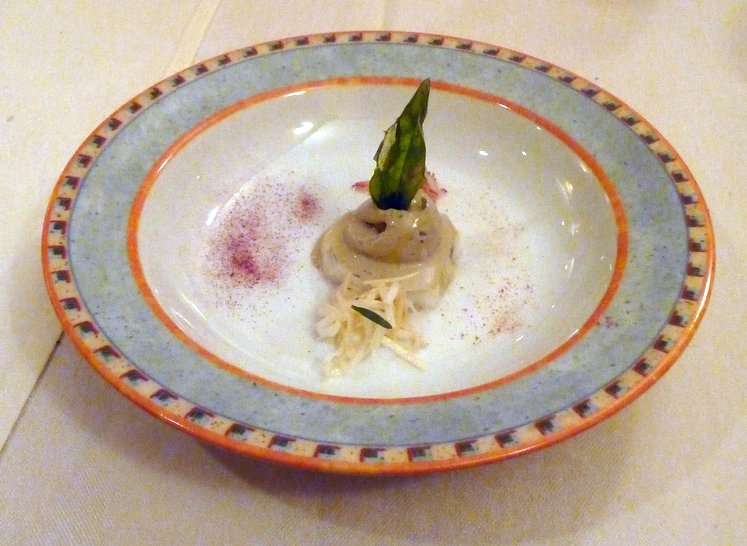 Bronze basil ice cream served atop an apple cucumber, with celery root slaw, icicle radish salad, beet powder, heirloom tomato powder, fried basil leaf
Bronze basil ice cream served atop an apple cucumber, with celery root slaw, icicle radish salad, beet powder, heirloom tomato powder, fried basil leaf
Eighth Course:
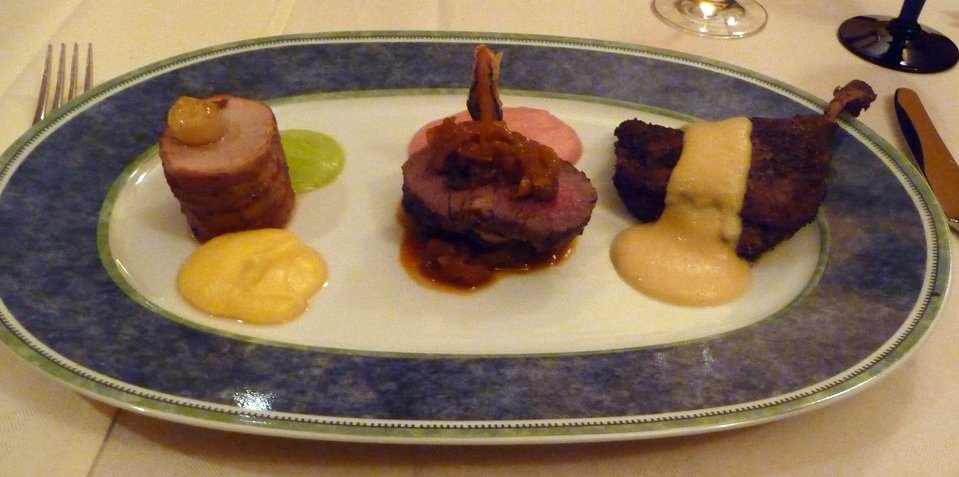 Meat course (from left to right):
Meat course (from left to right):
Sous-vide pork sirloin wrapped in venison bacon, silver shallot, delicato/buttercup squash puree, kohlrabi puree
Boiled "Kobe" (Wagyu) eye round, heirloom carrot and onions, pureed potatoes with swiss chard stems, candied swiss chard stem
Olive oil-cured duck confit with sumac, sea salt, butter turnip and wild burdock puree
Ninth Course:
 Gamay Noir grape granita
Gamay Noir grape granita
Tenth Course:
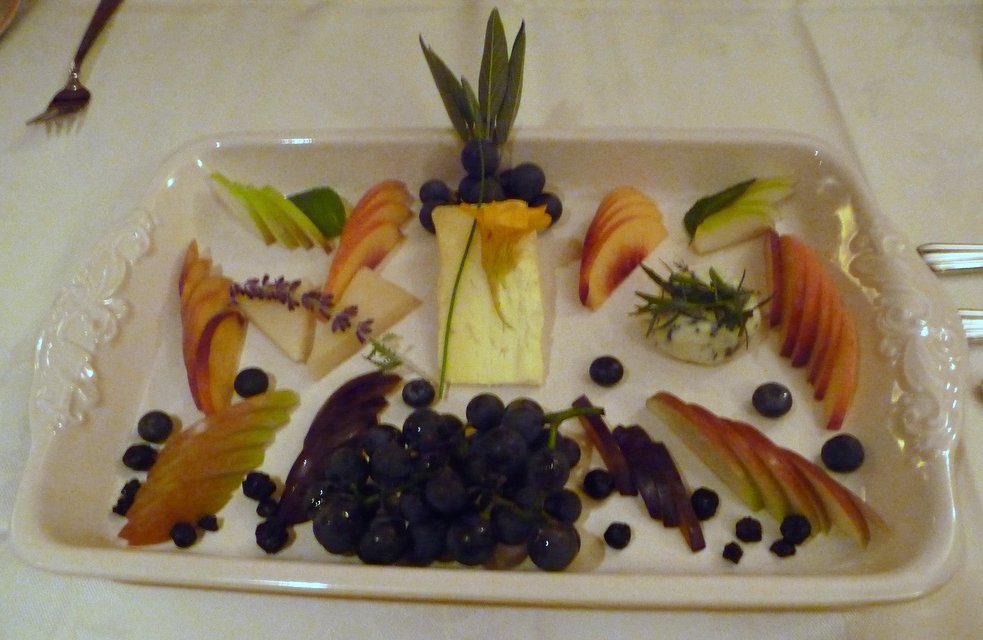
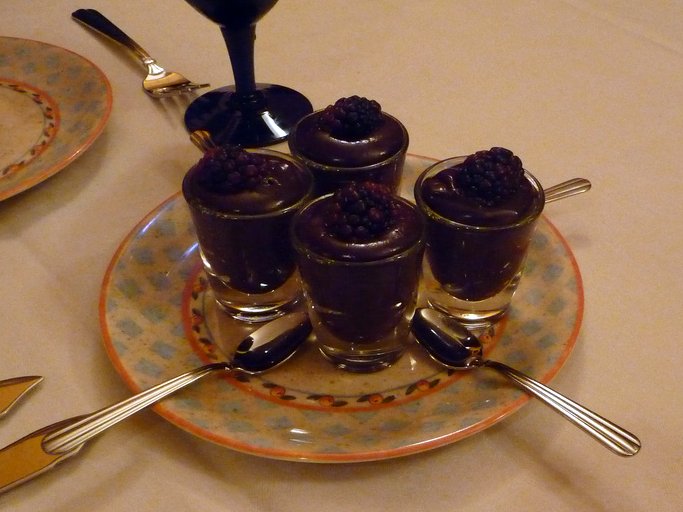 Cheese plate:
Cheese plate:
Roquefort-style blue cheese
unknown "fluffy" cheese
Maplewood-smoked pecorino-style cheese
Apples, grapes, plums, nectarines, air-dried and fresh blueberries
Chocolate "pudding": Tempered Valrhona chocolate with skim milk and blackberry
Eleventh Course:
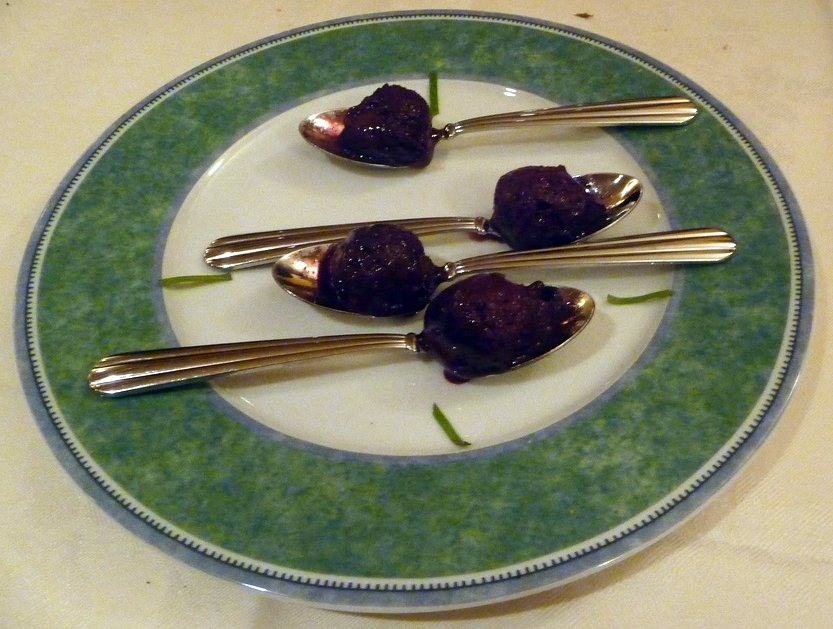 Mulberry and blackberry sorbet
Mulberry and blackberry sorbet
If you have any questions about the particulars of this meal, please feel free to ask in the comments and I'll answer them to the best of my ability.
Update: The price of this meal is now $235. Also, the restaurant has been renamed Damon Baehrel at the Basement Bistro.
Suddenly, $75 didn't seem like an expensive meal. After a five hour meal with Chef Damon Baehrel - owner, host, chef, waiter, sommelier, farmer, cheesemaker, butcher, dishwasher, carpenter, etc. - at the helm, I found myself wondering how he could possibly serve so much for such little money.
How does he do it? Chef Baehrel debunks the old adage by being not only a Jack of All Trades, but also a master of all of them. It's not just that he grows his own produce on the grounds surrounding his restaurant, and organically at that, but he also makes his own cheeses (from locally-sourced organic milk), bakes his own breads (with wheat from a local grain mill), cures his own charcuterie (from meat raised specifically for him in an organic, sustainable fashion), churns his own butter, and so on. Besides mastering traditional methods, his techniques - all self-taught - would be right at home on the menus of cutting-edge restaurants like wd~50 in NYC and Alinea in Chicago. That spinach powder adorning the stuffed heirloom tomato? Chef Baehrel dried the spinach and pulverized it into a fine dust himself. He's currently curing tomato "bacon" that he'll be serving beginning in January. Wylie Dufresne and Grant Achatz could learn a thing or two from this guy.
Another aspect of the Basement Bistro that helps keeps the cost down is its location. Although it's not an actual "bistro", it is located in a basement. A basement in a run-of-the-mill suburban-style house. (Which, by the way, was also built by Chef Baehrel.) The dining room was remodeled a half-dozen years ago, but it's still pretty basic by most standards. But its stripped-down atmosphere only goes to further the allure of this place - not only are you eating an incredible meal, you're eating that meal in some guy's basement.
The final measure in place to keep the price down is the payroll. Or lack thereof, I should say. One of the most impressive features of the Basement Bistro is that it's pretty much a solitary undertaking. Besides some help from his wife on the business side of things, and a former culinary intern who has transitioned to a part-time reservationist, Chef Baehrel is doing it all by himself. And he has been, while also running a catering company, cooking classes, and restaurant consulting outfit, for the past 18 years. The man must never sleep. (And on certain nights, he doesn't. When we walked out at 10:10 pm this past Saturday night, he began preparing for a party of 20 that would be joining him at 11 pm. He suspected that he'd maybe get an hour nap in before he had to start making the bread the next morning at 6 am.)
I could go on and on about what makes this place so special. And perhaps I will upon subsequent vists. (The menu changes daily, but I'm shooting for quarterly pilgrimages.) But at this time I'm just going to let the food speak for itself. I won't critique each course - there were far too many highs and nothing, and I mean nothing, that wasn't at least very good. Most dishes, in fact, leaned towards magnificent, or revelatory, or just simply jaw-dropping. (My dining companions, which consisted of my wife and my two amazing friends Mark and Cris who introduced me to this place, didn't quite get it when I said that a dish was "slap yo' mama" good, but I can surmount that a few of you out there will understand what I'm talking about.) I apologize if I didn't catch everything perfectly - it's incredibly hard to write when you're trying to take in all of what Chef Baehrel is saying, and even harder when a plate of his food is staring up at you.
So, without further ado, here's a pictorial journey through a meal at the Basement Bistro.
Entrance from the road:
Entrance to the restaurant:

Bread:
 Housemade bread: A focaccia-style bread made with basil flowers, and a sort of "everything bread" made with homemade onion powder, among other things. Served with freshly-churned butter and olive oil imported from a customer's olive farm in Greece.
Housemade bread: A focaccia-style bread made with basil flowers, and a sort of "everything bread" made with homemade onion powder, among other things. Served with freshly-churned butter and olive oil imported from a customer's olive farm in Greece.First Course:
 Charcuterie (all cured in-house, clockwise from top):
Charcuterie (all cured in-house, clockwise from top):Goose "salami" Icelandic lamb cured with coriander
Grass-fed beef brasaola
Kurobuta (Berkshire) pork "speck"
Small bites (from top):
Nasturtium flower, coated in rice flour and baked, served on a sunchoke puree*
Baby green beans wrapped in lamb prosciutto with heirloom carrot puree
Heirloom tomato with swiss chard and spinach powder
Cheeses (all made in-house, clockwise from top):
Blue cheese with sage
Camembert-style cheese
(unknown variety with fried parsley)
Earlton cheese (chef's own recipe)
Goat chevre with apple and nectarine confit
* It should be noted that most of his purees and sauces use a rutabaga stock at various reductions instead of cream or butter. It's amazing how much of a creamy texture this method gives a sauce without adding extra fat
Second Course:
 Savory Cones: Parsley-oil "cones" with pureed purple bush beans, green eggplant, and green sunflower seeds
Savory Cones: Parsley-oil "cones" with pureed purple bush beans, green eggplant, and green sunflower seedsThird Course:
 Salmon "BLT": Peachwood-smoked salmon, basil, heirloom tomato, lavender and marjoram aioli
Salmon "BLT": Peachwood-smoked salmon, basil, heirloom tomato, lavender and marjoram aioliFourth Course:
 Seafood course* (from left to right):
Seafood course* (from left to right):Peekytoe crab with squash blossom puree and cauliflower powder
Oyster poached in tomato water with heirloom carrot salad and squash seeds
Salt and pepper prawn with saffron cabbage "slaw"
* All seafood is provided by a vendor from Maine, who makes the Basement Bistro the first stop on the way to New York City
Fifth Course:
 Puffball "Soup": Puffball mushroom puree with applewood smoked corn, watermelon radish flower
Puffball "Soup": Puffball mushroom puree with applewood smoked corn, watermelon radish flowerSixth Course:
 Frozen duo*:
Frozen duo*:Wild pink current sorbet
Oven-roasted peach gelato
* Instead of using sugar or another sweetener, he uses unripened grape juice to sweeten his frozen confections
Seventh Course:
 Bronze basil ice cream served atop an apple cucumber, with celery root slaw, icicle radish salad, beet powder, heirloom tomato powder, fried basil leaf
Bronze basil ice cream served atop an apple cucumber, with celery root slaw, icicle radish salad, beet powder, heirloom tomato powder, fried basil leafEighth Course:
 Meat course (from left to right):
Meat course (from left to right):Sous-vide pork sirloin wrapped in venison bacon, silver shallot, delicato/buttercup squash puree, kohlrabi puree
Boiled "Kobe" (Wagyu) eye round, heirloom carrot and onions, pureed potatoes with swiss chard stems, candied swiss chard stem
Olive oil-cured duck confit with sumac, sea salt, butter turnip and wild burdock puree
Ninth Course:
 Gamay Noir grape granita
Gamay Noir grape granitaTenth Course:

 Cheese plate:
Cheese plate:Roquefort-style blue cheese
unknown "fluffy" cheese
Maplewood-smoked pecorino-style cheese
Apples, grapes, plums, nectarines, air-dried and fresh blueberries
Chocolate "pudding": Tempered Valrhona chocolate with skim milk and blackberry
Eleventh Course:
 Mulberry and blackberry sorbet
Mulberry and blackberry sorbetIf you have any questions about the particulars of this meal, please feel free to ask in the comments and I'll answer them to the best of my ability.
Update: The price of this meal is now $235. Also, the restaurant has been renamed Damon Baehrel at the Basement Bistro.
Wednesday, September 17, 2008
Wait for it ...
Variety (via New York Magazine) reports that the excellent How I Met Your Mother has been picked up for syndication ... in 2010. It will air on Fox affiliates in NYC, LA, and Chicago, and CBS other stations in five more major markets. Several cable outlets have also put in bids, including ABC Family, Comedy Central, and Spike.

Saturday, September 6, 2008
Esquire E Ink cover
I just picked up the October 2008 issue of Esquire magazine, the one with the controversial E Ink cover. Whether you like the idea or are against it, it is kind of cool.
Here's the cover of the magazine:
And here's the inside cover, which is an ad for the Ford Flex:
You can find higher definition versions of the cover and ad here and here, respectively.
Here's the cover of the magazine:
And here's the inside cover, which is an ad for the Ford Flex:
You can find higher definition versions of the cover and ad here and here, respectively.
Monday, September 1, 2008
Do's and don'ts of J'Ouvert Brooklyn

Every Labor Day, the West Indian Day parade - also known as Carnival - turns Eastern Parkway in Brooklyn into a sea of feathers, soca, and jerk chicken. It attracts upwards of three million people and is one of the premier parties in the United States.
Little known, however, is another parade that begins a little earlier in the morning - at 2 am to be precise. It's called J'Ouvert (from the French jour ouvert, or day open), and it's a somewhat smaller, more intimate affair. Unlike the million watt sound systems of Carnival, J'Ouvert is limited to steel drum "floats" - ragtag collections of pushcarts pulled along by U-Haul vans. It's a fantastic party, and because of the smaller size, everyone is encouraged to march along with the bands. (More on that later.)
Anyways, little is found on the web regarding this party, so I thought I'd share some do's and don'ts for enjoying J'Ouvert.
DO NOT: Show up at 2 am. It'll probably be a ghost town. There's a big Dimanche Gras party that goes until 2 am, and then people take their time getting situated. It's a West Indian party, and everyone is on Caribbean time. Get there at 4:30 am and you'll be fine. That's when things started moving last night.
DO: Start at the Grand Army Plaza side of Flatbush Avenue, at the Brooklyn Public Library. The bands get set up on Flatbush between Eastern Parkway and Empire Boulevard. It then travels down Empire until Nostrand Avenue, where it takes a right and continues on to Linden Boulevard.
DO NOT: Wear nice clothes. You will get dirty. There's baby powder. And sparkles. And lots of paint - most of which doesn't seem to be water soluble. Unless you're quick, you'll get hit with one or more of these objects.
DO: Bring something to drink. There's nothing around on this stretch of Flatbush, and there was only one person selling bottles of water along the route in the wee hours. If you're going to dance, you'll want water. And perhaps something else. Remember, clear "liquids" are for clear bottles only. For beverages of mixed elements, I'd consider a SIGG. I'll let you draw your own conclusions, and of course I would never suggest breaking the law. Even if it is only a $25 fine these days.
DO NOT: Go to this parade if you're not prepared to take part in the celebration. You may find yourself being warned to "Dance or go home" by a very large Haitian woman in a skimpy French maid's outfit. That was the point last night where I decided that I was done taking pictures and should start dancing. Large Haitian/French maids are very persuasive.
DO: Find your favorite band early, and get as close as you can. While El Dorado - City of Gold seemed to be very popular, I was more impressed with a non-descript band of probably 30 or so steel pan players. Take the time before the parade starts moving to see all of the bands strutting their stuff, and stick to the one that seems to suit your taste. And be prepared to like the song that they're currently playing - it's likely that they'll only play that and perhaps one other tune.
DO NOT: Start after Empire Boulevard. It seems that once you get to Bedford Avenue, foot traffic is one-way only - away from the parade. If you leave the cordoned-off area, you won't be able to get back in. Well, at least easily.
DO: Grab some food from the food vendors set up along Empire. I had a fantastic bake and saltfish from a Trinidadian/Guyanese vendor near Rogers Avenue. There's lots of places serving corn soup, and by 6 am there was jerk chicken being thrown on makeshift grills constructed from oil drums. If you're not a fan of street food (even though you should be), Hammond's Bakery and Jerk Center on Nostrand is open all night for all of your jerk needs.
Got any other tips? Please post them in the comments.
Sunday, August 31, 2008
Artichoke flowers - the new puppies?

Yesterday morning, while at the Union Square Greenmarket (aka farmer's market) in NYC, I picked up an artichoke flower for my wife. During my walk through the market to the subway entrance, and my subsequent subway ride back to Brooklyn, no fewer than two dozen people stopped me to ask what I was carrying.
By the time I returned home, I became convinced of this fact - an artichoke flower may perhaps be the cheapest and quickest way to meet someone in the city. Men and women of all ages stopped me to inquire about my purchase, which cost all of $5. In NYC, this attention is typically doled out upon only one other object - puppies, the cutest of which can cost upwards of $5,000. So, for 1/10 of 1% of the cost of a canine, I received the same amount of attention as the bearer of a cockapoo or puggle.
So, to all those people looking to meet other people, I suggest skipping the walking, the plastic bags, and the shredded shoes, and just pick up an artichoke flower. Hermits, shut-ins, and other socially-averse types, on the other hand, might want to steer clear.
Subscribe to:
Posts (Atom)
